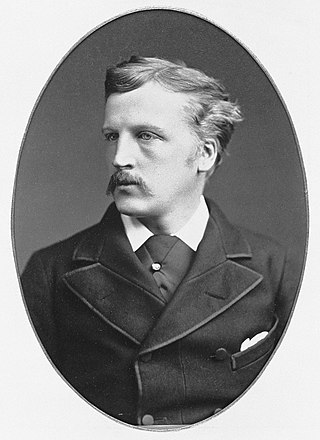
John George Edward Henry Douglas Sutherland Campbell, 9th Duke of Argyll, usually better known by the courtesy title Marquess of Lorne, by which he was known between 1847 and 1900, was a British nobleman who was Governor General of Canada from 1878 to 1883. He was the husband of Princess Louise, fourth daughter of Queen Victoria. He was the first president of "Rangers Football Club", thanks to his Argyll ties to the original founders of the football club.

Sussex Drive, also known as Ottawa Regional Road 93, is an arterial road in Ottawa, Ontario, the capital of Canada. It is one of the city's main ceremonial and institutional routes. Travelling roughly parallel to the Ottawa River, Sussex Drive begins as a continuation of Sir George-Étienne Cartier Parkway at Rideau Gate, at the entrance to Rideau Hall. It travels south to Rideau Street, with the portion south of St. Patrick Street forming the northbound half of a one-way pair with Mackenzie Avenue. Both Mackenzie Avenue and Sussex Drive connect with Colonel By Drive at their southern end, which continues south alongside the Rideau Canal.
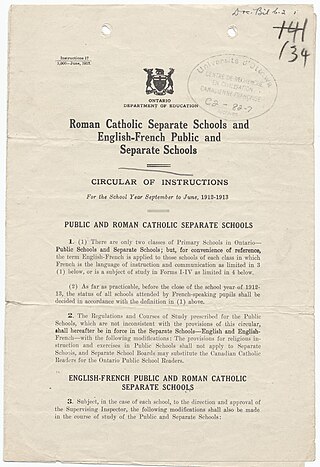
Regulation 17 was a regulation of the Government of Ontario, Canada, designed to limit instruction in French-language Catholic separate schools. The regulation was written by the Ministry of Education and was issued in July 1912 by the Conservative government of premier Sir James P. Whitney. It forbade teaching French beyond grade two in all separate schools.

The Canadian Northern Railway (CNoR) was a historic Canadian transcontinental railway. At its 1923 merger into the Canadian National Railway, the CNoR owned a main line between Quebec City and Vancouver via Ottawa, Winnipeg, and Edmonton.
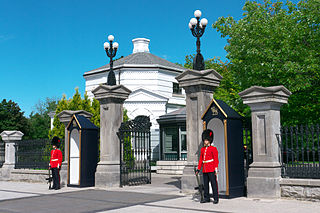
New Edinburgh is a neighbourhood in Rideau-Rockcliffe Ward, in Ottawa, Ontario, Canada. It is located to the northeast of the downtown core. It is bordered on the west by the Rideau River, to the north by the Ottawa River, to the south by Beechwood Avenue, and on the east by Springfield Road and the former Rockcliffe Park village limits.
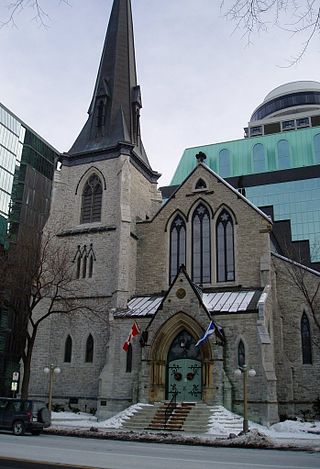
St. Andrew's Presbyterian Church is the oldest Presbyterian church in Ottawa, Ontario, Canada.

The Presbyterian Church in Canada is a Presbyterian denomination, serving in Canada under this name since 1875. The United Church of Canada claimed the right to the name from 1925 to 1939. According to the Canada 2021 Census 301,400 Canadians identify themselves as Presbyterian, that is, 0.8 percent of the population.

St. Bartholomew's Anglican Church is a place of worship in Ottawa, Ontario, Canada. The building was constructed in the latter half of the 19th century and serves the surrounding neighbourhoods. Additionally, St. Bartholomew's is, due to its location next to Rideau Hall, the place of worship for various Governors General of Canada and some members of the Canadian Royal Family. It is also the regimental chapel of the Governor General's Foot Guards.
Thomas McKay was a Canadian businessman who was one of the founders of the city of Ottawa, Ontario.

Stittsville is a suburban community, part of the Canadian capital of Ottawa, Ontario. It is within the former Goulbourn Township. A part of the National Capital Region, Stittsville is immediately to the southwest of Kanata, adjacent to Richmond and about 20 km (12 mi) west of Downtown Ottawa. The urban part of the community corresponds to Stittsville Ward on Ottawa City Council and has been represented by Glen Gower since 2018. As of 2021, Stittsville ward had a population of 40,889.
Ross and Macdonald was one of Canada's most notable architecture firms in the early 20th century. Based in Montreal, Quebec, the firm originally operated as a partnership between George Allen Ross and David MacFarlane from 1907 to 1912. MacFarlane withdrew from the firm in 1912, and Robert Henry Macdonald became a partner.
Thomas McKay (1792–1855) was a Scottish-born Canadian businessman and co-founder of Ottawa, Ontario.
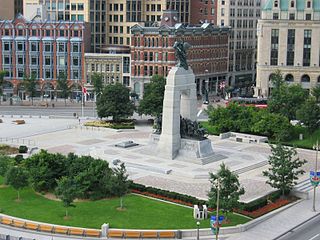
Confederation Square is an urban square in Ottawa, Ontario, Canada, and is considered the second most important ceremonial centre in Canada's capital city, after Parliament Hill. Roughly triangular in area, with Canada's National War Memorial at its centre and the Valiants Memorial at its periphery, the square is bounded by Wellington Street to the north and branches of Elgin Street to the east and west.
All Saints' Anglican Church is a former Anglican church in Ottawa, Ontario, Canada. The building was sold in 2015 and is currently a community hub for the neighbourhood, called All Saints Sandy Hill.
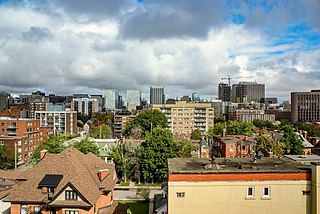
Centretown is a neighbourhood in Somerset Ward, in central Ottawa, Ontario, Canada. It is defined by the city as "the area bounded on the north by Gloucester Street and Lisgar Street, on the east by the Rideau Canal, on the south by the Queensway freeway and on the west by Bronson Avenue." Traditionally it was all of Ottawa west of the Rideau Canal, while Lower Town was everything to the east. For certain purposes, such as the census and real estate listings, the Golden Triangle and/or Downtown Ottawa is included in Centretown and it is considered part of Centretown by the Centretown Citizens Community Association as well as being used in this way in casual conversation.

The Ottawa River timber trade, also known as the Ottawa Valley timber trade or Ottawa River lumber trade, was the nineteenth century production of wood products by Canada on areas of the Ottawa River and the regions of the Ottawa Valley and western Quebec, destined for British and American markets. It was the major industry of the historical colonies of Upper Canada and Lower Canada and it created an entrepreneur known as a lumber baron. The trade in squared timber and later sawed lumber led to population growth and prosperity to communities in the Ottawa Valley, especially the city of Bytown. The product was chiefly red and white pine.The Ottawa River being conveniently located with access via the St. Lawrence River, was a valuable region due to its great pine forests surpassing any others nearby. The industry lasted until around 1900 as both markets and supplies decreased, it was then reoriented to the production of wood pulp which continued until the late 1990s and early 2000s.
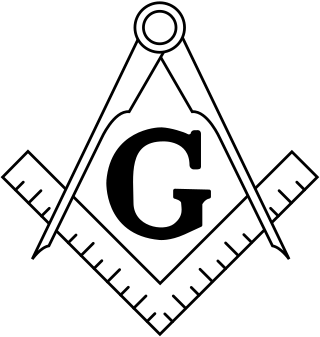
Freemasonry is a fraternal organisation that arose from the loose organization of medieval masons working in the medieval building industry.
Cecil Burgess (1888–1956) was a Canadian architect. He was born in Walkden, Lancashire, England on 8 July 1888. He was educated Walkden, Lancashire, England. He articled to Henry Kirkby, an architect in Manchester, England. Cecil Burgess arrived in Ottawa, Ontario with his parents in 1905. He married Violet Hervey from Round Hill, Nova Scotia, in 1913. The couple had a son, Bernard W. Burgess of Montreal, and a daughter, Mrs. Barbara Joyce Greenwood.

The Highland Church was a Gaelic-speaking congregation of the Church of Scotland, based in Tollcross, Edinburgh. Formed by the union of St Oran's Church and St Columba's Gaelic Church in 1948, the congregation continued united with Tolbooth St John's in 1956.
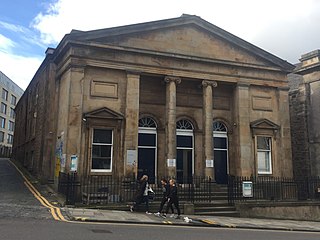
St Oran's Church was a Gaelic-speaking congregation of the Church of Scotland in Edinburgh. Originating in the early 18th-century, the congregation continued until 1948, latterly meeting at Broughton Street.
















